engine TOYOTA YARIS HATCHBACK 2020 (in English) Workshop Manual
[x] Cancel search | Manufacturer: TOYOTA, Model Year: 2020, Model line: YARIS HATCHBACK, Model: TOYOTA YARIS HATCHBACK 2020Pages: 572, PDF Size: 7.94 MB
Page 204 of 572
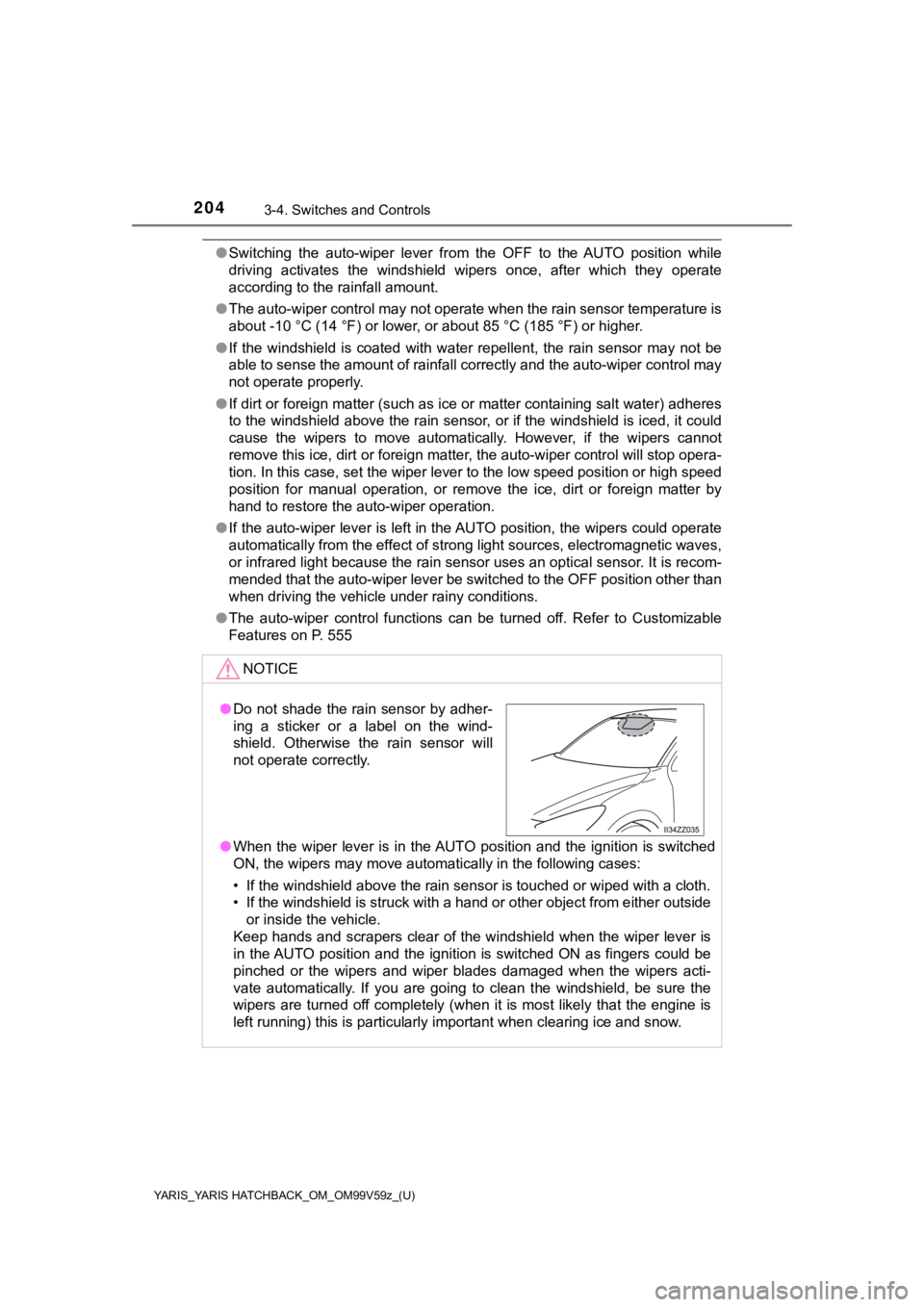
204
YARIS_YARIS HATCHBACK_OM_OM99V59z_(U)
3-4. Switches and Controls
●Switching the auto-wiper lever from the OFF to the AUTO positio n while
driving activates the windshield wipers once, after which they operate
according to the rainfall amount.
● The auto-wiper control may not operate when the rain sensor tem perature is
about -10 °C (14 °F) or lower, or about 85 °C (185 °F) or higher.
● If the windshield is coated with water repellent, the rain sens or may not be
able to sense the amount of rainfall correctly and the auto-wip er control may
not operate properly.
● If dirt or foreign matter (such as ice or matter containing sal t water) adheres
to the windshield above the rain sensor, or if the windshield i s iced, it could
cause the wipers to move automatically. However, if the wipers cannot
remove this ice, dirt or foreign matter, the auto-wiper control will stop opera-
tion. In this case, set the wiper lever to the low speed positi on or high speed
position for manual operation, or remove the ice, dirt or forei gn matter by
hand to restore the auto-wiper operation.
● If the auto-wiper lever is left in the AUTO position, the wipers could operate
automatically from the effect of strong light sources, electrom agnetic waves,
or infrared light because the rain sensor uses an optical senso r. It is recom-
mended that the auto-wiper lever be switched to the OFF positio n other than
when driving the vehicle under rainy conditions.
● The auto-wiper control functions can be turned off. Refer to Cu stomizable
Features on P. 555
NOTICE
● When the wiper lever is in the AUTO position and the ignition is switched
ON, the wipers may move automatically in the following cases:
• If the windshield above the rain sensor is touched or wiped with a cloth.
• If the windshield is struck with a hand or other object from e ither outside
or inside the vehicle.
Keep hands and scrapers clear of the windshield when the wiper lever is
in the AUTO position and the ignition is switched ON as fingers could be
pinched or the wipers and wiper blades damaged when the wipers acti-
vate automatically. If you are going to clean the windshield, be sure the
wipers are turned off completely (when it is most likely that t he engine is
left running) this is particularly important when clearing ice and snow.
●Do not shade the rain sensor by adher-
ing a sticker or a label on the wind-
shield. Otherwise the rain sensor will
not operate correctly.
Page 209 of 572
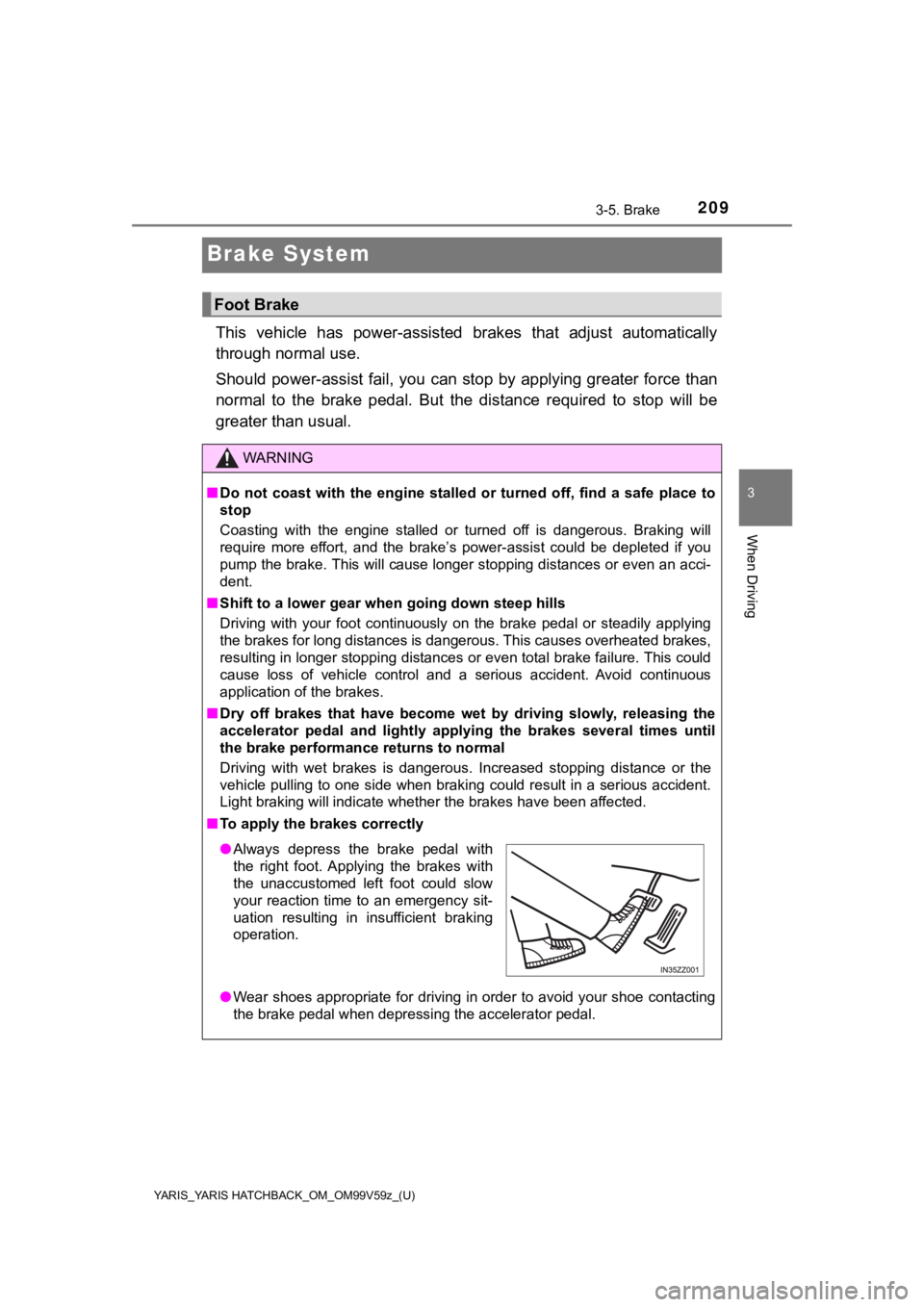
209
YARIS_YARIS HATCHBACK_OM_OM99V59z_(U)
3-5. Brake
3
When Driving
Brake System
This vehicle has power-assisted brakes that adjust automatically
through normal use.
Should power-assist fail, you can stop by applying greater forc e than
normal to the brake pedal. But the distance required to stop wi ll be
greater than usual.
Foot Brake
WARNING
■ Do not coast with the engine stalled or turned off, find a safe place to
stop
Coasting with the engine stalled or turned off is dangerous. Br aking will
require more effort, and the brake’s power-assist could be depleted if you
pump the brake. This will cause longer stopping distances or even an acci-
dent.
■ Shift to a lower gear whe n going down steep hills
Driving with your foot continuously on the brake pedal or steadily applying
the brakes for long distances is dangerous. This causes overheated brakes,
resulting in longer stopping distances or even total brake fail ure. This could
cause loss of vehicle control and a serious accident. Avoid con tinuous
application of the brakes.
■ Dry off brakes that have become wet by driving slowly, releasin g the
accelerator pedal and lightly applying the brakes several times until
the brake performance returns to normal
Driving with wet brakes is dangerous. Increased stopping distan ce or the
vehicle pulling to one side when braking could result in a seri ous accident.
Light braking will indicate whether the brakes have been affect ed.
■ To apply the brakes correctly
● Wear shoes appropriate for driving in order to avoid your shoe contacting
the brake pedal when depressing the accelerator pedal.
● Always depress the brake pedal with
the right foot. Applying the brakes with
the unaccustomed left foot could slow
your reaction time to an emergency sit-
uation resulting in insufficient braking
operation.
Page 215 of 572
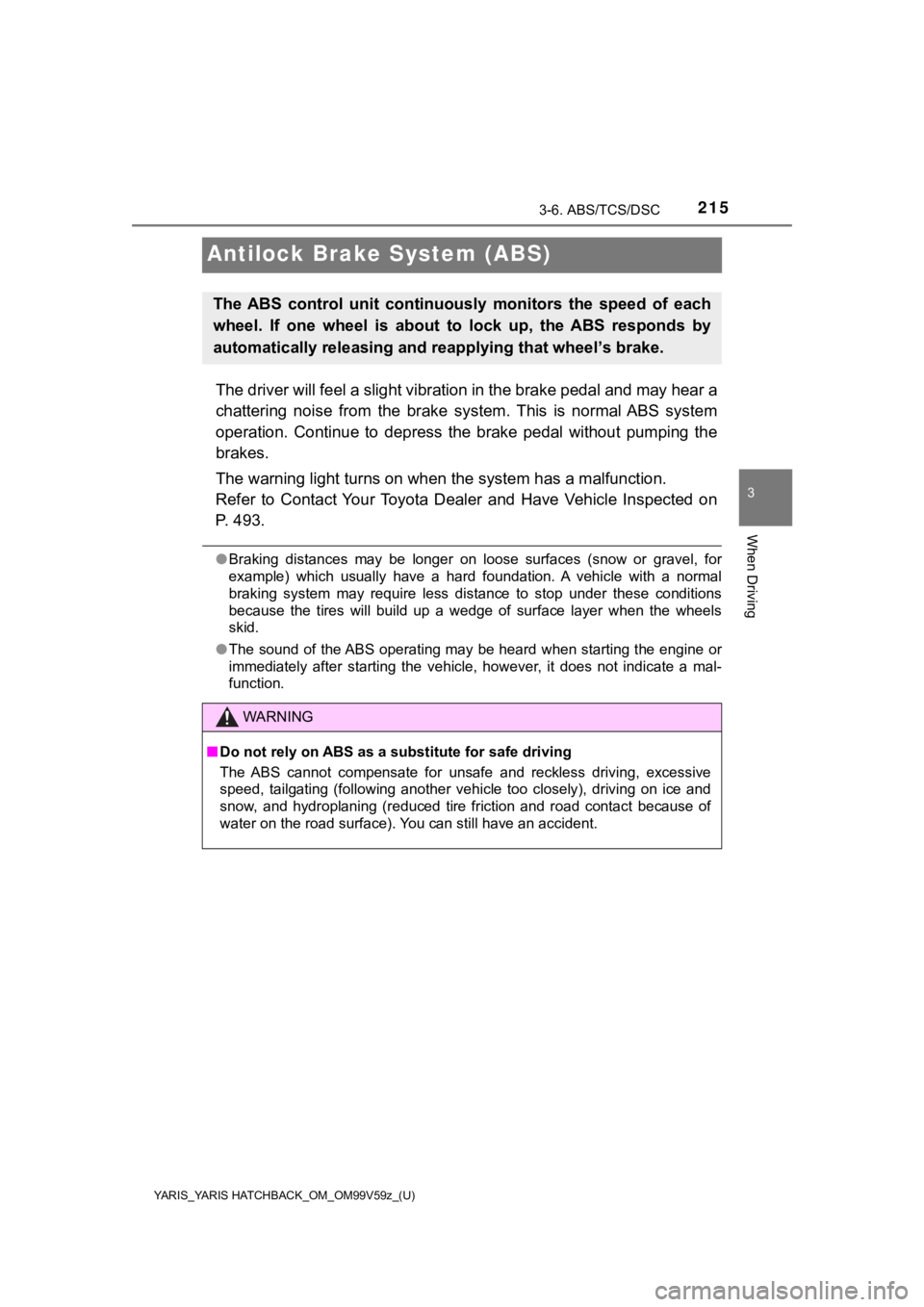
215
YARIS_YARIS HATCHBACK_OM_OM99V59z_(U)
3-6. ABS/TCS/DSC
3
When Driving
Antilock Brake System (ABS)
The driver will feel a slight vibration in the brake pedal and may hear a
chattering noise from the brake system. This is normal ABS syst em
operation. Continue to depress the brake pedal without pumping the
brakes.
The warning light turns on when the system has a malfunction.
Refer to Contact Your Toyota Dealer and Have Vehicle Inspected on
P. 493.
● Braking distances may be longer on loose surfaces (snow or grav el, for
example) which usually have a hard foundation. A vehicle with a normal
braking system may require less distance to stop under these co nditions
because the tires will build up a wedge of surface layer when t he wheels
skid.
● The sound of the ABS operating may be heard when starting the engine or
immediately after starting the vehicle, however, it does not in dicate a mal-
function.
The ABS control unit continuously monitors the speed of each
wheel. If one wheel is about to lock up, the ABS responds by
automatically releasing and reapplying that wheel’s brake.
WARNING
■ Do not rely on ABS as a su bstitute for safe driving
The ABS cannot compensate for unsafe and reckless driving, exce ssive
speed, tailgating (following another vehicle too closely), driv ing on ice and
snow, and hydroplaning (reduced tire friction and road contact because of
water on the road surface). You can still have an accident.
Page 216 of 572
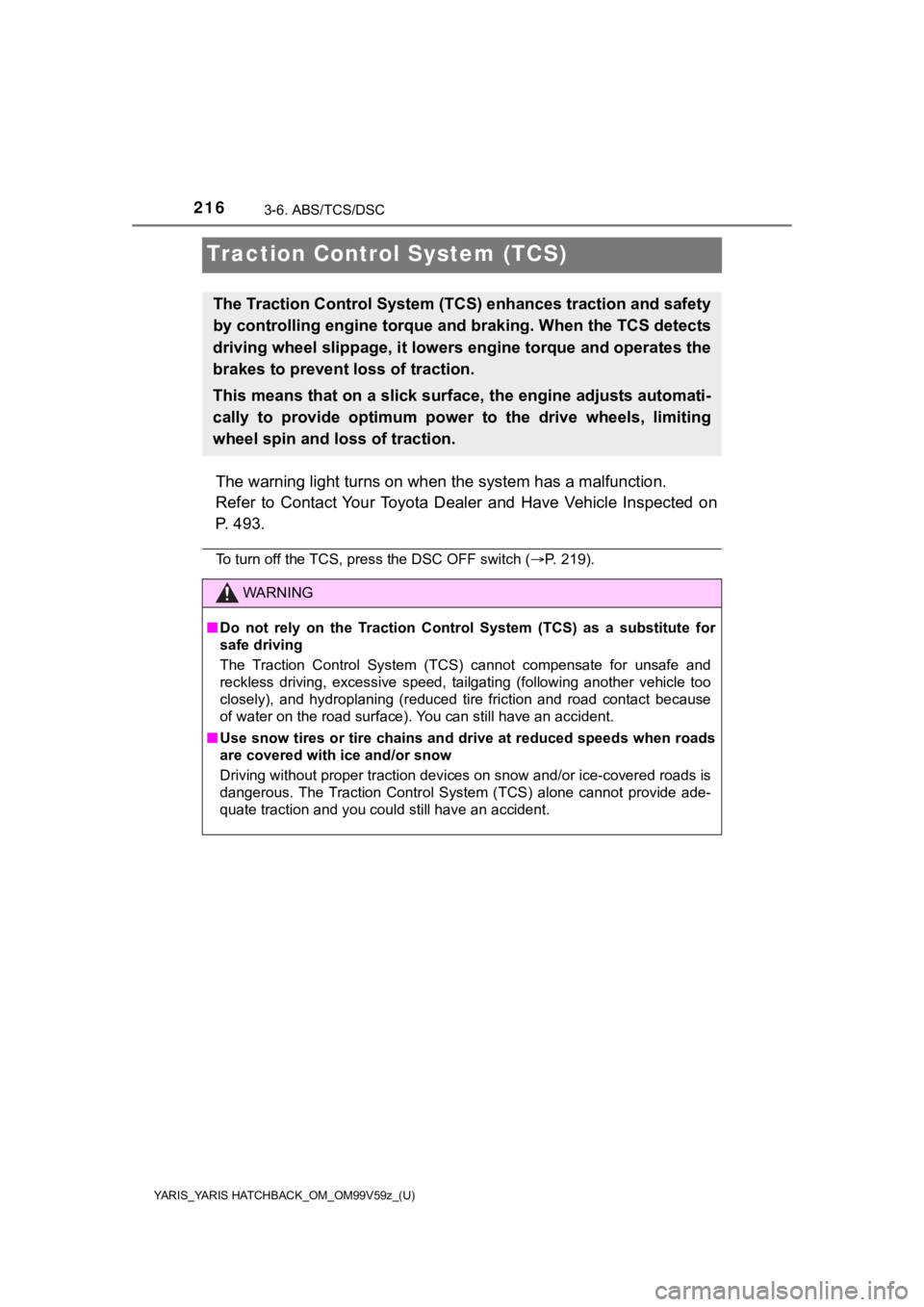
216
YARIS_YARIS HATCHBACK_OM_OM99V59z_(U)
3-6. ABS/TCS/DSC
Traction Control System (TCS)
The warning light turns on when the system has a malfunction.
Refer to Contact Your Toyota Dealer and Have Vehicle Inspected on
P. 493.
To turn off the TCS, press the DSC OFF switch ( P. 219).
The Traction Control System (TCS) enhances traction and safety
by controlling engine torque and braking. W hen the TCS detects
driving wheel slippage, it lower s engine torque and operates th e
brakes to prevent loss of traction.
This means that on a slick surface , the engine adjusts automati-
cally to provide optimum power to the drive wheels, limiting
wheel spin and loss of traction.
WARNING
■ Do not rely on the Traction Cont rol System (TCS) as a substitute for
safe driving
The Traction Control System (TCS) cannot compensate for unsafe and
reckless driving, excessive speed, tailgating (following anothe r vehicle too
closely), and hydroplaning (reduced tire friction and road contact because
of water on the road surface). You can still have an accident.
■ Use snow tires or tire chains and drive at reduced speeds when roads
are covered with ice and/or snow
Driving without proper traction devices on snow and/or ice-cove red roads is
dangerous. The Traction Control System (TCS) alone cannot provide ade-
quate traction and you could still have an accident.
Page 217 of 572
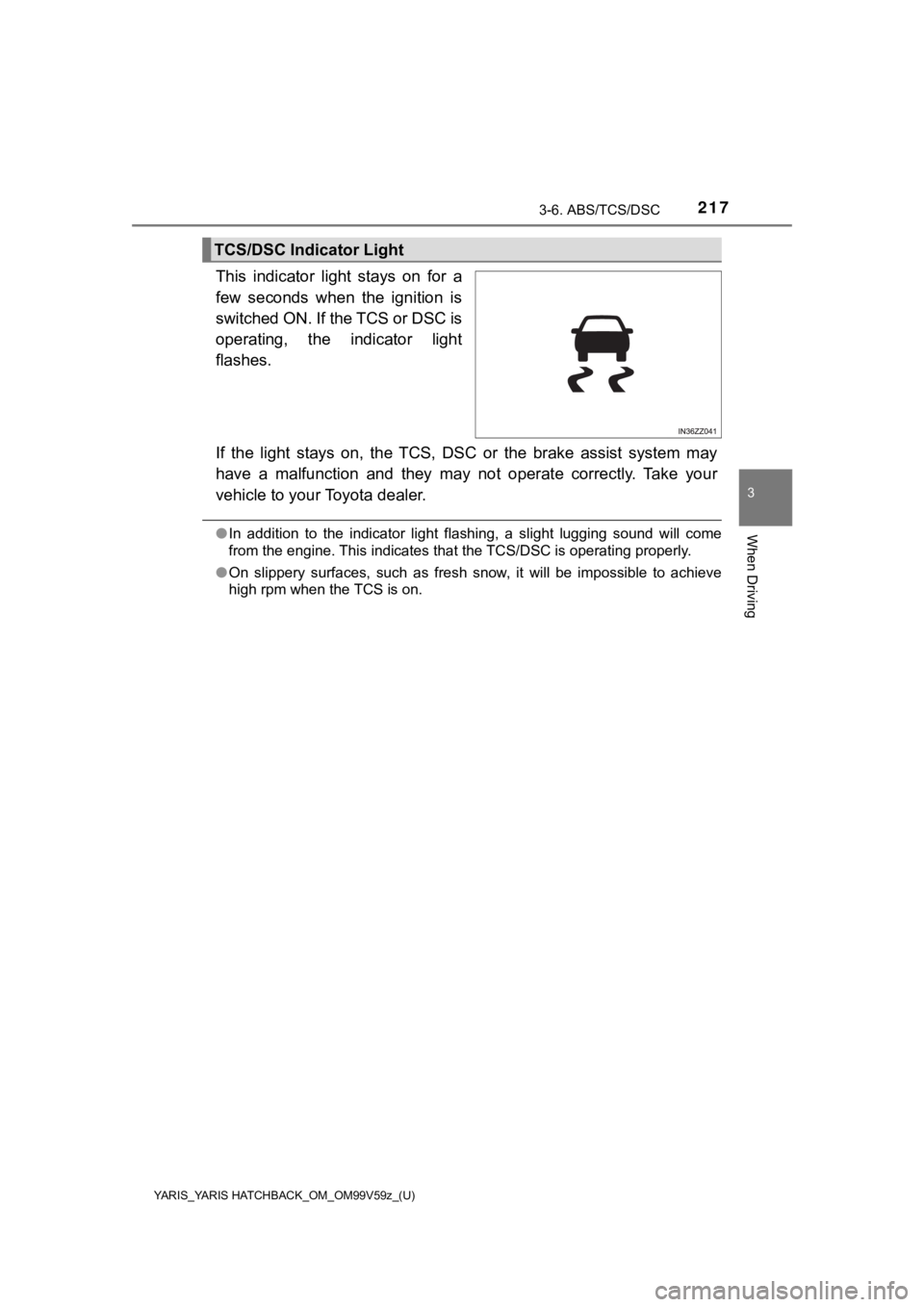
YARIS_YARIS HATCHBACK_OM_OM99V59z_(U)
2173-6. ABS/TCS/DSC
3
When Driving
This indicator light stays on for a
few seconds when the ignition is
switched ON. If the TCS or DSC is
operating, the indicator light
flashes.
If the light stays on, the TCS, DSC or the brake assist system may
have a malfunction and they may not operate correctly. Take you r
vehicle to your Toyota dealer.
● In addition to the indicator light flashing, a slight lugging s ound will come
from the engine. This indicates that the TCS/DSC is operating p roperly.
● On slippery surfaces, such as fresh snow, it will be impossible to achieve
high rpm when the TCS is on.
TCS/DSC Indicator Light
Page 218 of 572
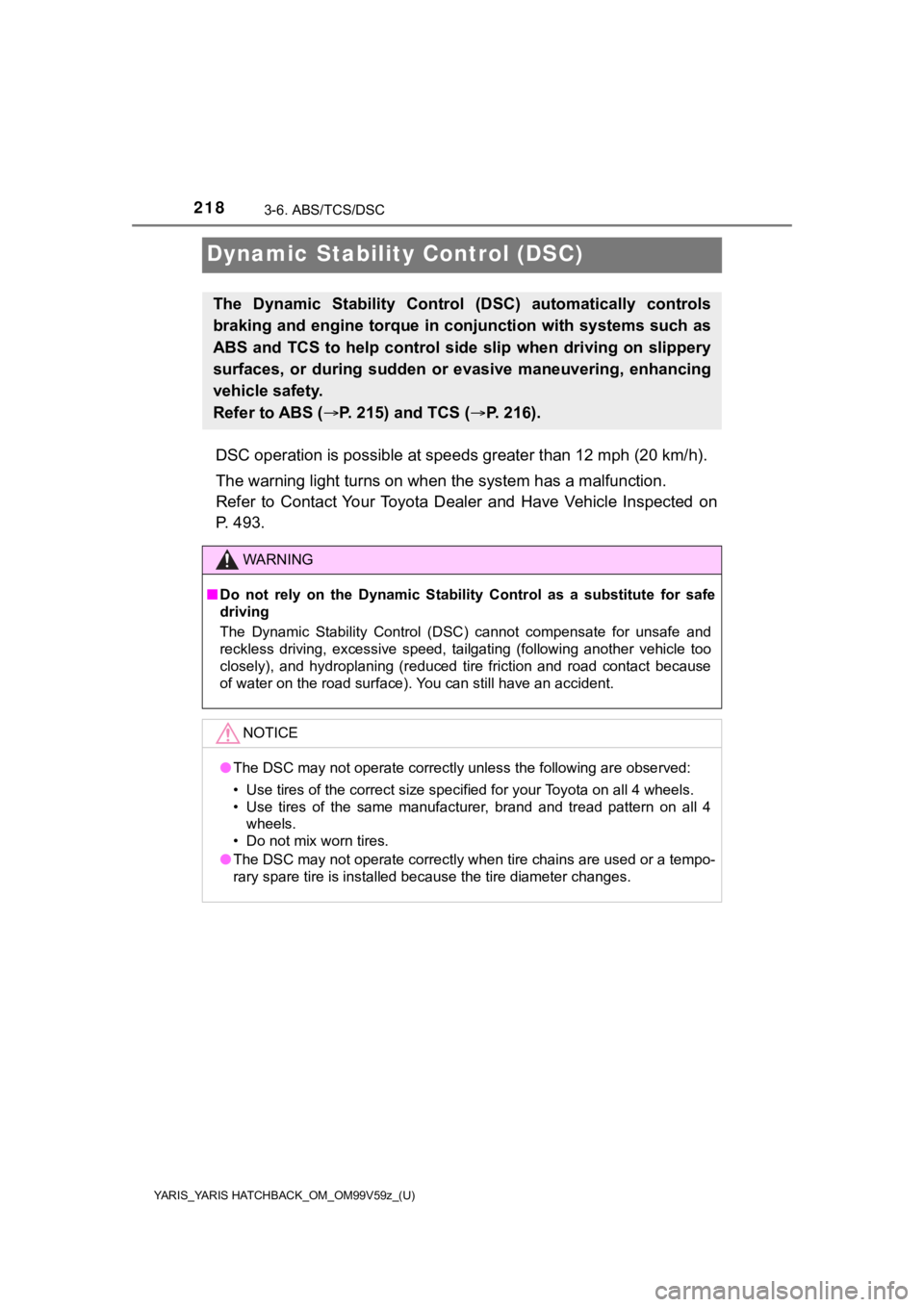
218
YARIS_YARIS HATCHBACK_OM_OM99V59z_(U)
3-6. ABS/TCS/DSC
Dynamic Stability Control (DSC)
DSC operation is possible at speeds greater than 12 mph (20 km/h).
The warning light turns on when the system has a malfunction.
Refer to Contact Your Toyota Dealer and Have Vehicle Inspected on
P. 493.
The Dynamic Stability Control ( DSC) automatically controls
braking and engine torque in c onjunction with systems such as
ABS and TCS to help control si de slip when driving on slippery
surfaces, or during sudden or e vasive maneuvering, enhancing
vehicle safety.
Refer to ABS ( P. 215) and TCS ( P. 216).
WARNING
■Do not rely on the Dynamic Stabil ity Control as a substitute for safe
driving
The Dynamic Stability Control (DSC) cannot compensate for unsaf e and
reckless driving, excessive speed, tailgating (following anothe r vehicle too
closely), and hydroplaning (reduced tire friction and road contact because
of water on the road surface). You can still have an accident.
NOTICE
● The DSC may not operate correctly unless the following are obse rved:
• Use tires of the correct size specified for your Toyota on all 4 wheels.
• Use tires of the same manufacturer, brand and tread pattern on all 4 wheels.
• Do not mix worn tires.
● The DSC may not operate correctly when tire chains are used or a tempo-
rary spare tire is installed because the tire diameter changes.
Page 220 of 572

220
YARIS_YARIS HATCHBACK_OM_OM99V59z_(U)
3-6. ABS/TCS/DSC
●When DSC is on and you attempt to free the vehicle when it is stuck, or
drive it out of freshly fallen snow, the TCS (part of the DSC s ystem) will acti-
vate. Depressing the accelerator will not increase engine power and freeing
the vehicle may be difficult. When this happens, turn off the TCS/DSC.
● If the TCS/DSC is off when the engine is turned off, it automat ically activates
when the ignition is switched ON.
● Leaving the TCS/DSC on will provide the best traction.
● If the DSC OFF switch is pressed and held for 10 seconds or mor e, the DSC
OFF switch malfunction detection function operates and the DSC system
activates automatically. The DSC OFF indicator light turns off while the DSC
system is operative.
● If the Low Speed Pre-Collision System operates with the TCS/DSC turned
off, the TCS/DSC becomes operational automatically.
Page 224 of 572
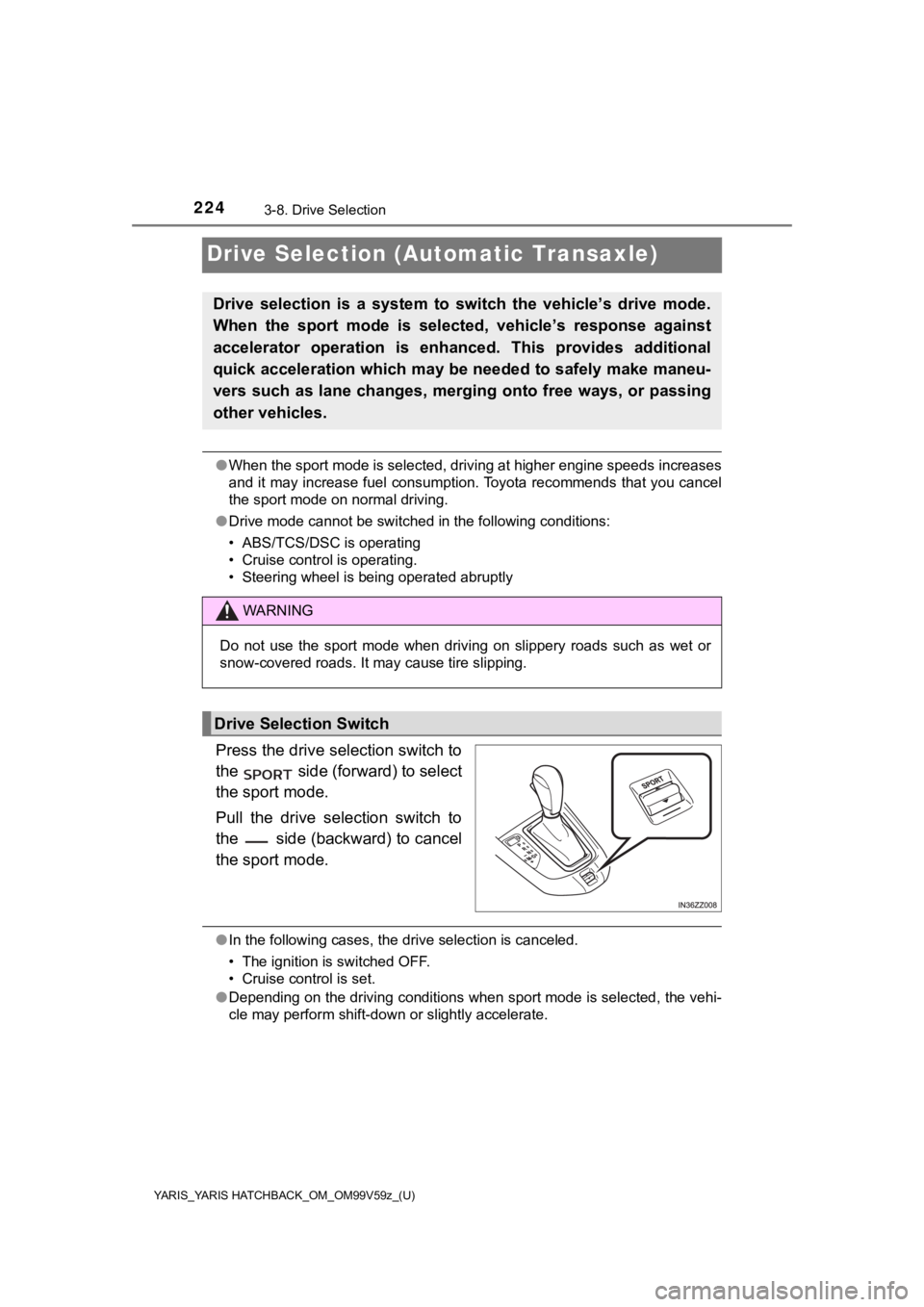
224
YARIS_YARIS HATCHBACK_OM_OM99V59z_(U)
3-8. Drive Selection
Drive Selection (Automatic Transaxle)
●When the sport mode is selected, driving at higher engine speed s increases
and it may increase fuel consumption. Toyota recommends that you cancel
the sport mode on normal driving.
● Drive mode cannot be switched in the following conditions:
• ABS/TCS/DSC is operating
• Cruise control is operating.
• Steering wheel is being operated abruptly
Press the drive selection switch to
the side (forward) to select
the sport mode.
Pull the drive selection switch to
the side (backward) to cancel
the sport mode.
●In the following cases, the drive selection is canceled.
• The ignition is switched OFF.
• Cruise control is set.
● Depending on the driving conditions when sport mode is selected , the vehi-
cle may perform shift-down or slightly accelerate.
Drive selection is a system to switch the vehicle’s drive mode.
When the sport mode is selected, vehicle’s response against
accelerator operation is enhanc ed. This provides additional
quick acceleration which may be needed to safely make maneu-
vers such as lane changes, merging onto free ways, or passing
other vehicles.
WARNING
Do not use the sport mode when driving on slippery roads such a s wet or
snow-covered roads. It may cause tire slipping.
Drive Selection Switch
Page 226 of 572

226
YARIS_YARIS HATCHBACK_OM_OM99V59z_(U)
3-9. Power Steering
Power Steering
• Power steering is only operable when the engine is running. If the
engine is off or if the power steering system is inoperable, you can
still steer, but it require s more physical effort.
If the steering feels stiffer than usual during normal driving or the
steering vibrates, consul t your Toyota dealer.
• The warning light notifies the driver of system abnormalities and
operation conditions.
In addition, the buzzer may als o activate depending on the syst em
abnormality or operation condition.
Refer to Stop Vehicl e in Safe Place Imme diately on P. 489.
Refer to Power Steering Warning Buzzer on P. 505.
NOTICE
Never hold the steering wheel to the extreme left or right for more than 5
seconds with the engine running. This could damage the power steering
system.
Page 229 of 572

YARIS_YARIS HATCHBACK_OM_OM99V59z_(U)
2293-10. Active Safety System
3
When Driving
●The Low Speed Pre-Collision System will not operate if the driv er is deliber-
ately performing driving operations (accelerator pedal and stee ring wheel).
● The Low Speed Pre-Collision System will operate under the follo wing condi-
tions.
• The engine is running.
• The Low Speed Pre-Collision System warning light (amber) does not illu-
minate.
• The vehicle speed is between about 2 to 18 mph (4 to 30 km/h).
• The Low Speed Pre-Collision System is not turned off.
• The DSC is not malfunctioning.
● The Low Speed Pre-Collision System detects a vehicle ahead by emitting a
near-infrared laser beam and receiving the beam reflected off the reflector
of the vehicle ahead, and then using it for the measurement. Co nsequently,
the Low Speed Pre-Collision System may not operate under the following
conditions:
• Reflection of the laser is poor due to the shape of the vehicl e ahead.
• The vehicle ahead is significantly dirty.
• Under bad weather condition, such as rain, fog and snow.
• The window washer is being used or the windshield wipers are not used when it’s raining.
• The windshield is dirty.
• The steering wheel is turned completely left or right, or the vehicle is
accelerated rapidly and comes close to the vehicle ahead.
• Trucks with low loading platforms and vehicles with an extreme ly low or
high profile.
• Vehicles with certain shapes such as a vehicle carrier.
● Under the following conditions, the Low Speed Pre-Collision Sys tem may
not operate normally.
• Heavy luggage is loaded in the luggage compartment or on the r ear seat.
• If there is the possibility of partial contact with a vehicle ahead.
• When driving on continuously curving roads, and entering and e xiting
exits.
• Elongated luggage or cargo is loaded onto installed roof rails and covers
the laser sensor.
• Exhaust gas from the vehicle in front, sand, snow, and water v apor rising
from manholes and grating, and water splashed into the air.
• When towing a malfunctioning vehicle.
• When driving with tires having significantly different wear.